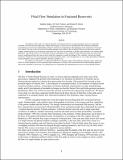Fluid Flow Simulation in Fractured Reservoirs
Author(s)
Sarkar, Sudipta; Toksoz, M. Nafi; Burns, Daniel R.
DownloadSARKAR.PDF (770.7Kb)
Other Contributors
Massachusetts Institute of Technology. Earth Resources Laboratory
Metadata
Show full item recordAbstract
The purpose of this study is to analyze fluid flow in fractured reservoirs. In most petroleum reservoirs, particularly carbonate reservoirs and some tight sands, natural fractures play a critical role in controlling fluid flow and hence production. Uncertainties involved in the understanding of fracture architecture and properties often propagate in the construction of reservoir flow models. The state-of-the-art reservoir simulation packages used widely in the oil industry often do not take into account the complex random geometry of real fracture systems that can vary from one grid-block to another, and sometimes even within a single grid-block. The reason for this is two-fold: there exists no technology as yet to image the micro-fractures in-situ, and most of the reservoir modeling software does not use micro-scale flow equations to model the change of flow variables. Fractures are highly conductive channels for flow among all types of porous-permeable media, Flow through them can vary widely depending on different fracture properties, such as fracture apertures, densities, asperities, etc.
The objective of this study is to understand fluid flow in fractures using a finite difference approach, and to analyze the effects of fracture properties on flow mainly through visualization. Contrary to the conventional macro-scale modeling approach, micro-scale simulation is carried out. The ultimate goal is to incorporate this information into reservoir scale modeling schemes.
Date issued
2002Publisher
Massachusetts Institute of Technology. Earth Resources Laboratory
Series/Report no.
Earth Resources Laboratory Industry Consortia Annual Report;2002-12